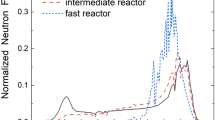Abstract
The canisters with spent nuclear fuel produced during the operation of WWER reactors at the Czech power plants are planned, like in other countries, to be disposed of in an underground repository. Canisters will be surrounded by compacted bentonite that will retard the migration of safety-relevant radionuclides into the host rock. A new code that enables the modelling of the critical radionuclides transport from the canister through the bentonite layer in the cylindrical geometry was developed. The code enables to solve the diffusion equation for various types of initial and boundary conditions by means of the finite difference method and to take into account the non-linear shape of the sorption isotherm. A comparison of the code reported here with code PAGODA, which is based on analytical solution of the transport equation, was made for the actinide chain 4N+3 that includes 239Pu. A simple parametric study of the releases of 239Pu, 129I, and 14C into geosphere is discussed.
Similar content being viewed by others
References
Romero L., Moreno L., and Neretnieks I.: Nuclear Technology 113 (1996) 316.
Vieno T. and Nordman H.: Interim Report on Safety Assessment of Spent Fuel Disposal, POSIVA-96-17, December 1996, 176 pp.
Tsukamoto M. and Fujita T.: in Proc. 6th Int. Conf. on Radioactive Waste Management and Environmental Remediation, Singapore 1997 (Eds. R. Baker, S. State, and G. Benda), ASME International, New York, 1997, p. 309.
McGrail B. P.: Nuclear Technology 123 (1998) 82.
PAGODA, Version 3.3, Technical Manual, Quantisci, XVT Software Inc., 1990.
Ueng T. S. and O’Connel W. J.: Nuclear Technology 108 (1994) 80.
Badoin P. et al.: Spent Fuel Disposal Performance Assessment (SPA project), European Commission Report, Euratom, EUR 19132 EN, 2000, 114 pp.
Berner U.: Estimates of Solubility Limits for Safety Relevant Radionuclides, Nagra Techn. Report 94-08, April 1995, 58 pp.
Carbol P. and Engkvist I.: Compilation of Radionuclide Sorption Coefficients for Performance Assessment, SKB Rapport R-97-13, September 1997, 67 pp.
Reference Project of the Deep Geological Repository, http://www.vidivici.cz/surao/zacateka.htm
Grambow B.: Spent Fuel, Dissolution and Oxidation—An Evaluation of Literature Data, SKB Techn. Report 89-13, 1989, 42 pp.
ORIGEN 2.1, Isotope Generation and Depletion Code, CCC-371, RSIC Computer Code Collection, Oak Ridge National Laboratory, Oak Ridge, TN, 1991.
Author information
Authors and Affiliations
Rights and permissions
About this article
Cite this article
Vopálka, D., Vokál, A. A new code for modelling the near field diffusion releases from the final disposal of nuclear waste. Czech J Phys 53 (Suppl 1), A127–A133 (2003). https://doi.org/10.1007/s10582-003-0019-6
Issue Date:
DOI: https://doi.org/10.1007/s10582-003-0019-6




